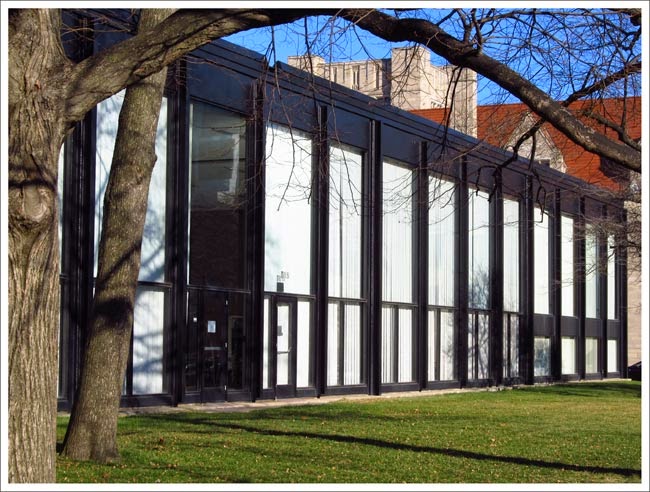School of Social Service Administration Building
by: chicago designslinger
[School of Social Service Administration Building (1965) Mies van der Rohe, architect /Image & Artwork: chicago designslinger]
In 1887 27-year-old Jane Addams went on a trip to Europe, visited the world's first settlement house in London - Toynbee Hall - and had a life changing experience. She came to Chicago, founded the first settlement house in the United States, and went on to become the first woman to win the Nobel Prize. In 1901 Sophonisba Breckinridge became the first woman to earn a PhD in political science from the University of Chicago and the first to earn a law degree in 1904. In 1905 29-year-old Edith Abbott earned her PhD in economics at the university and in 1909 her sister Grace earned her PhM from U of C in political science. All the women lived together at one time or another in Addams' Hull House, and together became a major force in creating the country's social service system.
[School of Social Service Administration Building, 969 E. 60th Street, Chicago /Image & Artwork: chicago designslinger]
In 1903 the University became involved in the education and training of future settlement house workers with Graham Taylor of Chicago Commons, a settlement house Taylor founded in 1896 modeled on Addams' Hull House. Seeking to further legitimatize their work through education and training, Taylor, along with University president William Rainey Harper created the Social Science Center for Practical Training in Philanthropy and Social Work - which lasted all of two years before the school pulled its funding. Taylor then switched gears and used his connections with Addams and her wealthy donors to start the Chicago School of Civics and Philanthropy. Chicago's social service community was a small tight-knit group, and between their close association with Addams and their relationship with the University and education, Breckinridge and the Abbott sisters became actively involved in ensuring the success of Taylor's new school. In 1920, through the efforts and financial clout of donors like Sears Roebuck chairman Julius Rosenwald, the University took Taylor's organization back under their wing, named the institution the School of Social Service Administration, and in 1924 appointed Edith Abbott as dean - the first woman in U.S. history to head a graduate school.
[School of Social Service Administration Building, University of Chicago /Image & Artwork: chicago designslinger]
Edith Abbott, Grace Abbott and Sophonisba Breckinridge became the heart and soul of the School, and through their groundbreaking work played an instrumental role in the mid-1930s assisting President Franklin Roosevelt in creating federal programs like Social Security. Professor of Public Welfare Administration Breckinridge retired from the University in 1933. Grace Abbott, a director in the Office of Social Security Administration, died in Washington D.C. in 1939, and Dean Abbott retired in 1942. In 1957 philanthropist Philip D. Block, a big financial supporter of the University, headed a committee authorized to find and fund a new home for the School. They settled on a site in 1967 located just south of the main campus, on the Midway, at the corner of 60th and Ellis Streets and began raising money for the design and construction for the new facility.
[School of Social Service Administration /Image & Artwork: chicago designslinger]
The University had maintained a presence on the corner since the turn of the century. A large single family home on the large corner lot provided office and classroom space, and the former stable and coach house in the rear had been converted into a studio by Chicago artist and sculptor Larado Taft. In 1929 the Taft studio complex was moved a block to the west, and after the site was selected by the committee, the old house was torn down to make way for the new School structure. And "new" was in at the time at the University. The institution was no longer interested in duplicating the Gothic Revival style that architect Henry Ives Cobb had established as the campus' defining look in the 1890s, and broke with the revival tradition by hiring the most famous modernist of the era, Ludwig Mies van der Rohe, as architect. By the time the ball got rolling in 1963, Mies was 77-years-old, suffering from chronic arthritis, and not coming into work on a regular basis. Architect Gene Summers was pretty much in charge of the office by then and led the design team on the building project. But no decision was ever made without van der Rohe's input, even if it meant taking drawings to the immobilized architect's apartment for final approval. The building was obviously descended from the Crown Hall family - Mies' masterwork on the IIT campus - but this project was given a thumbs down by many critics in the architectural community. The architect however, who showed-up for the dedication of the structure crutches in hand, was photographed with a big smile of approval on his face.




No comments:
Post a Comment
Note: Only a member of this blog may post a comment.